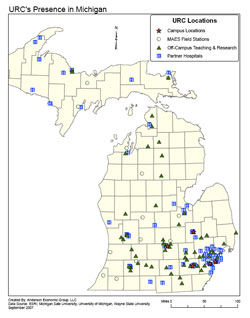
This web page is part of the Michigan Today Archive. To see this story in its original context, click here.
University Research Corridor creates 68,803 Michigan jobsUrging lawmakers to “invest in what works for Michigan,” the University Research Corridor presidents today released an independent analysis showing the state’s three research universities helped create 68,803 Michigan jobs and produced $12.8 billion of net economic benefit in 2006. “This report documents how Michigan’s URC universities have become a vital economic engine for the state,” said Patrick Anderson, principal and CEO of Anderson Economic Group, who led the four-month effort. “These institutions attract enormous amounts of research dollars, produce highly-trained graduates that attract employers around the country, and are some of the largest employers in the state. At a time when Michigan’s economy is suffering, it is important to note this is one sector where we have truly world-class institutions.” In an independent assessment of the economic role of the three URC institutions – Michigan State University, the University of Michigan and Wayne State University –AEG found the URC:
“Our competitors have been leveraging their assets and working together for decades while the URC is in its first year,” said University of Michigan President Mary Sue Coleman. “California’s long history of partnerships between universities, cutting edge businesses and government has set an impressive standard but in just our first year as partners we’re seeing limitless potential for the future.” The report measures the Research Corridor universities against six comparable clusters in regions known as knowledge economy leaders: Boston’s 128 Corridor: Harvard University/Massachusetts Institute of Technology (MIT) and Tufts University. “When state budgets are tight, it makes sense to invest our limited dollars where they will produce the greatest return,” said Wayne State President Irvin D. Reid. “No part of the budget produces a greater return on investment than education, and Michigan’s research universities have a unique role in fueling the state’s economic growth.” In 2004, Michigan’s R&D spending of $1.3 billion exceeded that of Harvard, MIT, and Tufts; as well as North Carolina’s Research Triangle universities and the Pennsylvania cluster, beating all the national competitors other than the two California clusters. By 2005, however, North Carolina’s Research Triangle surpassed Michigan’s URC, as North Carolina continued to boost its investments in higher education and research. The report found that Michigan’s R&D expenditures have produced significant commercial benefits, as indicated by licensing revenue. In terms of revenue received per dollar of expenditure, AEG concluded the URC performs better than four of the six comparison university clusters. “This report details how research universities create jobs,” said MSU President Lou Anna Simon. “Investing more in research universities fuels the growth of Michigan’s knowledge-based economy.”
To read the full report, click here (PDF) To learn more about the numerous companies begun with the help of URC partners and their research, visit: www.urcmich.org/numbers/URC_companies.html For more about the University Research Corridor, visit: www.urcmich.org For more on Anderson Economic Group LLC, visit: www.andersoneconomicgroup.com The URC issued a preliminary economic impact report in May 2007. View the prelimenary report: Preliminary Report: The economic benefits of the University Research Corridor.
|
|
Michigan Today is a monthly electronic publication for alumni and friends of U-M. |
| Michigan Today | |
|
|
Michigan Today
online alumni magazine
University Record
faculty & staff newspaper
MGoBlue
athletics
News Service
U-M news
Photo Services
U-M photography
University of Michigan
gateway

